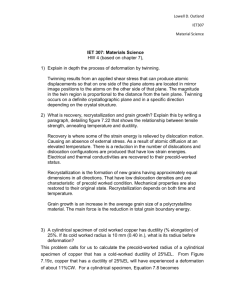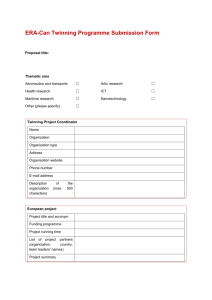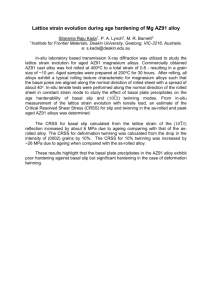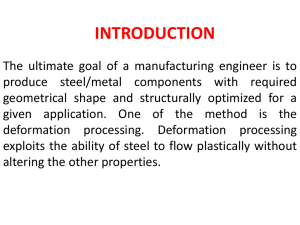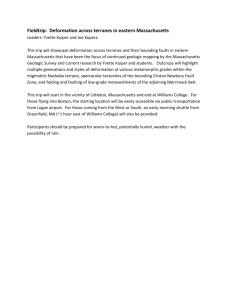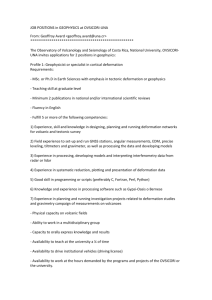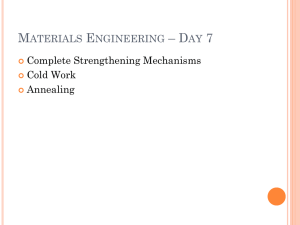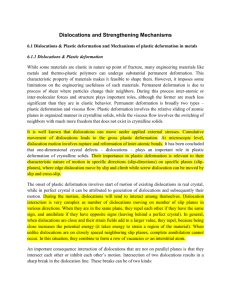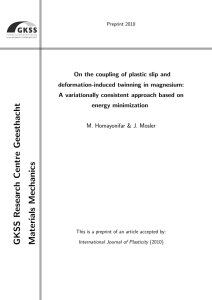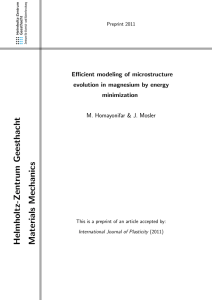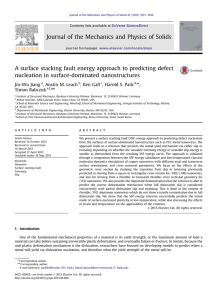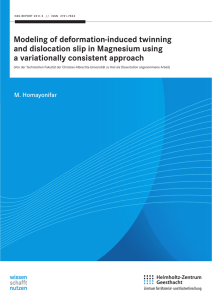Homework 4 - Devin Gatherwright IET 307 Portfolio
advertisement
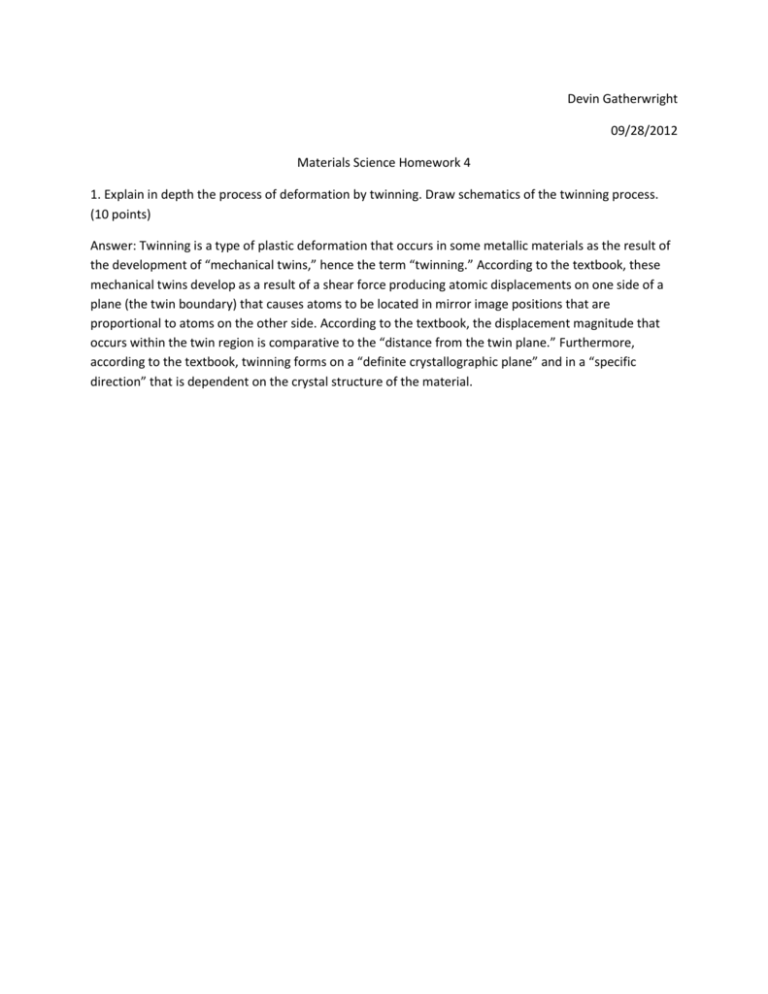
Devin Gatherwright 09/28/2012 Materials Science Homework 4 1. Explain in depth the process of deformation by twinning. Draw schematics of the twinning process. (10 points) Answer: Twinning is a type of plastic deformation that occurs in some metallic materials as the result of the development of “mechanical twins,” hence the term “twinning.” According to the textbook, these mechanical twins develop as a result of a shear force producing atomic displacements on one side of a plane (the twin boundary) that causes atoms to be located in mirror image positions that are proportional to atoms on the other side. According to the textbook, the displacement magnitude that occurs within the twin region is comparative to the “distance from the twin plane.” Furthermore, according to the textbook, twinning forms on a “definite crystallographic plane” and in a “specific direction” that is dependent on the crystal structure of the material. As you can see in the drawing above, the open circles represent atoms that did not change position; darkened circles represent atoms that changed position from the applied shear stress. 2. What is recovery, recrystallization and grain growth? Explain this by writing a paragraph, detailing figure 7.22 that shows the relationship between tensile strength, annealing temperature and ductility. (10 points) Answer: According to the textbook, recovery can be defined as “the relief of some of the internal strain energy of a previously cold-worked metal, usually by heat treatment.” According to the textbook, recrystallization can be defined as “the formation of a new arrangement of strain-free grains within a previously cold-worked material; usually an annealing heat treatment is required.” According to the textbook, grain growth can be defined as “The increase in average grain size of a polycrystalline material; for most materials, an elevated-temperature heat treatment is mandatory.” If you look at figure 7.22 on page 221, you can see how high annealing temperatures relieve the tensile strength of the material, which was brought about by the strain hardening method known as cold working. If you look at the graph, the high tensile strength of the material begins to decrease rapidly when the temperature is increased. In contrast, the low ductility of the material begins to increase rapidly when the temperature is increased. This is known as recovery, because the cold-worked material is recovery its previous properties when exposed to high temperatures. Also, in figure 7.22, you can see how annealing high temperatures increase the average grain size in a previously cold-worked material. This is known as grain-growth. Lastly, in figure 7.22, you will see that as the recrystallization temperature increases, new sets of strain-free grains occur to a previously cold worked material depending on the percent of cold work that was previously done to the material. This is known as recrystallization. Also, it should be noted that recrystallization will not occur in materials that have deformations less than 5% respectively. 3. A cylindrical specimen of cold-worked copper has ductility (% elongation) of 35.75%. If its cold-worked radius is 12.75 mm, what was its radius before deformation? (10 points) Answer: I found the following formula from Oregonstate.edu, which I used to solve this problem: 𝑅𝑖 2 12.75 𝑚𝑚2 𝑅𝑖 = √1−%𝐶𝑊 = √ 1−0.3575 = 15.9 𝑚𝑚 4. What is the difference between the slip and twinning mechanisms of plastic deformation of metals? Explain in detail. (10 points). Answer: According to the textbook, there are several notable differences between twinning and slip mechanisms of plastic deformation. One difference, according to the textbook, is that in slip deformations, the crystallographic orientation that is both above and below the slip plane remains the same after deformation has occurred, as well as before any deformation has occurred. In the case of twinning, a crystallographic reorientation will occur across the twin plane. Also, in addition to this, in slip deformation, a slip will occur in apparent atomic spacing multiples, whereas the atomic displacement that occurs in twinning deformation is noticeably less than the interatomic separation. Also, according to the textbook, in twinning deformation, mechanical twinning occurs at high loading rates, whereas the slip deformation is restricted at such high rates. Lastly, according to the textbook, in twinning deformation, the total bulk plastic deformation that occurs is normally small compared to the resulting bulk plastic deformation that occurs in slip deformation. 5. A sheet of aluminum alloy is cold-rolled 28.89% to a thickness of 0.12 in. If the sheet is then coldrolled to a final thickness of 0.22 in., what is the total percent cold work done? (10 points) Answer: %𝐶𝑊 = ( 𝐴1 = 𝜋 4 × (0.12 𝑖𝑛. )2 = 0.0113 𝑖𝑛.2 𝐴2 = 𝜋 4 × (0.22 𝑖𝑛. )2 = 0.0380 𝑖𝑛.2 𝐴2 − 𝐴1 0.0380 − 0.0113 ) × 100 = × ( ) × 100 = 70.26% 𝐴2 0.0380 28.89 70.26 + 100 100 = 99.15 200 ÷2= 49.56 100 = 49.56% 6. Metals like magnesium cannot be effectively strengthened using cold working, Explain why. (10 points) Answer: According to the Wikipedia article for magnesium alloy, magnesium alloys are prone to quickly harden during with any type of cold work method, and, according to the article, cannot be extensively cold formed without repeated head treatment (annealing) (Wikipedia.org). I assume that this repeated annealing of the magnesium alloy material decreases its strength during the cold working process. *I know the use of Wikipedia is frowned upon, but it was the only site where I could find this information. 7. Why is it difficult to improve both strength and ductility simultaneously? (10 points) Answer: It is difficult to improve both strength and ductility of a material simultaneously due to the phenomenon known as strain hardening. In strain hardening, a ductile metal is made to be stronger, but also becomes harder as a result. The increasing hardness of the material due to this phenomenon decreases the ability of the material to undergo plastic deformation (ductility) due to its newfound hardness and strength. Thus, it is difficult to both strengthen a material by strain hardening while trying to simultaneously improve its ductility. 8. A 5 in. diameter aluminum rod is reduced to a 3.5 in. diameter, and then reduced again to a final diameter of 2 in. In a second case, the 5 in. diameter rod is reduced in one step from a 5 in. to a 2 in. diameter. Calculate the % cold work for both cases. (10 points) Answer: 𝜋 × (5 𝑖𝑛. )2 = 19.63 𝑖𝑛.2 4 𝐴1 = 𝐴2 = 𝜋 × (3.5 𝑖𝑛. )2 = 15.60 𝑖𝑛.2 4 𝐴3 = 𝜋 × (2 𝑖𝑛. )2 = 3.14 𝑖𝑛.2 4 𝐴1 − 𝐴2 )× 𝐴1 %𝐶𝑊 = ( %𝐶𝑊 = 19.63−15.60 )× 19.63 100 = ( 100 = 20.53% 𝐴2 − 𝐴3 15.60 − 3.14 × 100 = ( ) × 100 = 79.87 % 𝐴2 15.60 20.53 79.87 100.4 50.2 + = ÷2= = 50.2 % 100 100 200 100 %𝐶𝑊 = 𝐴1 − 𝐴3 19.63 − 3.14 × 100 = ( ) × 100 = 84% 𝐴1 19.63 9. Cold-working can’t be used as a strengthening mechanism for materials that are going to be subjected to high temperatures during their use. Explain why. (10 points) Answer: Cold working can’t be used to strengthen materials that are going to be subjected high temperatures due to the fact that high temperatures will remove the mechanical properties of the material that were enhanced due to cold working. This means that the material will lose both its hardness and strength due to the fact that these properties were enhanced at extremely cool temperatures (hence the term “cold working.”) 10. 10. A 3105 aluminum wire is to be drawn to give a 1 mm diameter wire having a yield strength of 20,000 psi. Note – 3105 denotes a special composition of aluminum alloy (see the figure). (10 points) (a) Find the original diameter of the wire; (b) Calculate the draw force required; (c) Determine whether the as-drawn wire will break during the process. Answer: (A) Judging from the graph, 24 mm. (B) Judging from the graph, around 30% CW. (C) I don’t think it will. If you look at the graph, the tensile strength is also increases as the wire elongates and the yield strength increases due to the percentage of cold work being done to the material. Works Cited Magnesium Alloy. (Last modified June, 23, 2012). Wikipedia.org. Retrieved 09/30/2012, from http://en.wikipedia.org/wiki/Magnesium_alloy Warnes, W.H. ENGR322: Homework Set Four. (Last Updated April 26, 2010.) OregonState.edu. Retrieved 09/30/2012, from http://oregonstate.edu/instruct/engr322/Homework/AllHomework/S10/ENGR322HW4.html
